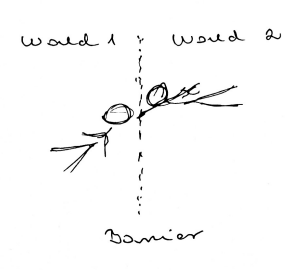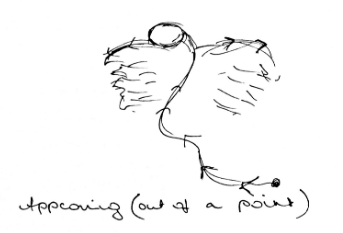What is the 10th Star?
- John Adams
- Jan 9, 2022
- 12 min read
Introduction

The Tenth Star involves a possible event occurring somewhere in our galaxy. It is related to an experience I had around 2011 in the dream state. However, what I thought may have been a very clear lucid dream upon waking in outer space turned out to be an out of body experience. I was given a message which said: "wait next for the Tenth Star". I somehow knew the source of the words was wise and powerful, more than I had ever felt before, and the message continued to haunt me for some years. Was it something to do with the tenth brightest star, or the tenth nearest star? Is it relative to our Sun, or the Earth? Is it merely personal or astrological (I don't follow it personally), or does it mean anything at all? I put it on the shelf, for the most part, not thinking there was any immediate answer.
Even though remote viewing holds promise in fields like Astronomy in helping to reveal information from long distances, these sessions don't not necessarily show proof of anything, however they are very interesting to look at and evaluate, as in Henrietta's sessions alone because they keyed in to the whole experience. After the Tenth Star we will examine the possibility of the next supernova occurring somewhere in the Milky Way galaxy in the future.
The target: What is meant by the "tenth star" and what will occur, if anything, as a result of this 'event'?
The viewers: DR, Henrietta Hajdu, Jemma Warner, John Adams, John Dixon, Lily Efflorescence, Malgorzata Abbott, Patrick Flanagan, and Chris Niemack added a short session at the end.
An out of body experience
First Henrietta depicts two individuals in what is labeled 'world 1' and 'world 2', separated by a barrier. She also drew a side view of a portal with clouds, followed by a subject passing through it and comparing to "when the gate in the movie stargate opens" out of a kind of fogginess. She then AOL'd OBE three times.



Next she depicts something with wings flying and carrying someone up. What is fascinating is that both Henrietta (above) and Jemma (below) drew and wrote down "the Creation of Adam painting" in relation to the set of targets given (during the Saturn Project).

Henrietta wrote radiant, energetic, revered, ascended, etheric and bright descriptors and of paintings of angels.
What she also keyed into in the subsequent session were negative visitors - a winged snake-looking creature, a djinn, and a subject leaning over a bed. This was indeed a phenomenon I witnessed from time to time, pretty much since childhood, before I began practicing energetic and remote healing. She described it as deceptive, manipulative and parasitic.
Of the original subject she included: winged lion, golden, royal, representing the sun, deity-like, revered, transcendental, powerful, symbolic, warrior-like, and fierce.

She also drew a winged lion and wrote: god, griffin, death, religious, paintings.

10th Star
In the search for what the 10th star could refer to, assuming the legitimacy of such a query in the first place, Regulus is one star that comes up, which in Astrology is in the 10th house. It is the brightest star in the constellation Leo and is known as the Heart of the Lion.
"Fixed star Regulus, Alpha Leonis, is a 1.4 magnitude blue-white star in Leo Constellation. Regulus is actually a quadruple star system composed of four stars that are organized into two pairs.
In Persian it was Miyan, ‘the Centre‘ and Venant, one of the four ‘royal stars’ of the Persian monarchy, where in 3,000 BC, as the Watcher of the North, it marked the summer solstice.
Symbolically the Crushing Foot, Regulus is associated with the healing Archangel Raphael, one of the four Archangel stars, characterized as the Four Horsemen of Apocalypse (Revelations 6) and Chariot Horses in the Book of Zechariah (The White went North).
"... Its image is a lion, cat, or an honorable person seated in a chair. It makes the wearer temperate, gives favor and appeases wrath."
"Regulus, one of the biggest stars in the night sky, is emitting light in a unique way and is rotating at such a speed that it is close to "flying apart"
"Scientists studied the light of the star and published their work in 2017: “We found Regulus is rotating so quickly it is close to flying apart, with a spin rate of 96.5 percent of the angular velocity for the break-up,” Daniel, from University of New South Wales (UNSW), Sydney, added. https://www.indiatvnews.com/science/news-regulus-one-of-the-brightest-stars-spinning-fast-enough-to-fly-apart-402280
Since the star resides some 77 light years away it is likely outside the immediate danger zone, although we don't know what the effect of such an occurrence would have entirely. It could influence evolution somehow and it could change the ozone layer and climate on Earth, once again assuming an event like this were to happen. I mention this star because of astrological and historical reasons, but the truth is there are any other possibilities.
Next, we have Qí Guān shí, the Tenth Star of Imperial Guards, also known as Alpha Lupi. Lupus, meaning “the wolf” in Latin, is one of the original 48 constellations catalogued by the Greek astronomer Ptolemy of Alexandria around 150 AD. It is a southern hemisphere constellation found between Centaurus and Scorpius, whose brightest star is Alpha Lupi, a blue-white giant located 460 light years away that shines with an apparent visual magnitude of 2.30.

The constellation of Lupus started out as a star-pattern (asterism) in the constellation of Centaurus, and to the ancients represented an animal that was being hunted or killed by a centaur. The impaled animal is seen as facing towards the nearby constellation of Ara (“The Altar”), which served as a shrine for the sacrifice. It is likely that the Greeks loosely based their version on a myth from the Babylonians, who associated the constellation with the Mad Dog, a mythical carnivorous human hybrid creature that could have been part dog, lion or wolf.
In the 3rd century BC, the ancient Greek astronomer Hipparchus separated it from Centaurus and renamed the new constellation Therium, meaning wild animal, and by around 150 AD, Ptolemy had entered it in his astronomical treatise called Almagest. The Romans subsequently chose to call it Bestia, meaning “the beast,” and the constellation continued to not have any one animal associated with it until the Renaissance when the Latin translation of Ptolemy’s work refined the animal’s identification to being a wolf, and so called it Lupus.
Principal Stars
– Alpha Lupi, the brightest star in Lupus, is a blue-white giant star (B1.5III) with a visual magnitude of 2.30, although being a Beta Cephei variable it experiences random variations in its brightness by about 0.03. Alpha Lupi is around 460 light years away from Earth, has a mass ten times greater than the Sun, and is also around 25,000 brighter.
– Beta Lupi, the constellation’s second brightest star, is also a blue-white giant (B2 III) found 383 light years distant. It is around 25 million years old, has 8 solar masses, and shines with a visual magnitude of 2.68, making it visible to the naked eye. Beta Lupi lies close to the remnants of SN 1006, a supernova explosion that in 1006 AD could be seen during the daytime, and was described as a “guest star”.
– Gamma Lupi, the third brightest star in the constellation, is a blue-white subgiant (B2 IV) that is around 420 light years from our solar system. It is, in fact, a close binary system that has a combined visual magnitude of 2.77.
Next is Sirius - Canis Major, the 10th closest star to Earth
"The tenth closest star is Sirius, the Dog star in the constellation of Canis Major and it is also the brightest star in the night sky. Sirius is a double star and the companion star would amount to being the 11th nearest." The star is close to Orion's belt, and for middle to Northern latitudes it's best seen during the winter in the southern part of the sky. At a distance is 8.60 Ly, this would put the star in very close range to Earth. Sirius B seems unlikely to go Supernova anytime soon (as in the next several million years), if ever at all. An article describing the unlikely scenario is here: https://www.ibtimes.sg/supernova-caused-by-nearby-star-sirius-b-could-destroy-earth-expert-claims-34964.
Other possibilities for the Tenth Star include the stars in Orion. Most notably is Betelgeuse (usually the 10th brightest star except for its recent variations), a candidate for supernova which has undergone tumultuous change of late, having released a cloud of dust that obscured its own brightness by at least some 30% in 2020 and leading some to believe the star may go supernova at any time (astronomers believe this could happen anywhere between now and 100,000 years - a short time frame in the typical lifespan of any star). Another candidate in Orion is Rigel (the foot of Orion). Neither of these stars are in the immediate vicinity of our solar system at roughly 650 light years away. At the same time, we have not had any nearby supernova occur in our lifetime so one may still wonder what minimal effects they could have on our planet.
Recently it was discovered that supernova explosions are far more common than we thought. Roughly every 50 years we might see a supernova occur somewhere in the Milky Way galaxy. Other possibilities could include still other stars in the top ten nearest or brightest categories from either the Sun or the Earth.
Let's again look at Henrietta's sessions.
Here she shows two spherical objects in rotation, one of them central. In the other image it is flattened and shown emitting energy.


With Jemma Warner's session we see something large and rounded expanding, getting brighter, then a "starburst", with a gaping hole that is large, cold, noisy.
Slideshow:

Having a look at Malgorzata Abbott's session, we have a central object in a swirl with descriptions of eyes hurting from white colors and exposure to sunlight. She also mentioned what seem to be metaphorical horses, like DR.
In my shorter, blind target pool session what I got was a spatial growth, drift, surface, place, destination, florid, floral, navigate, getting hotter, expanding, release, rise, a bed of clouds, a pathway, a trajectory, the far side of a place that seems temporal, and an AI of a bit like a roller coaster ride. I got turbulent, wall, energy, glow, motion, release, broad movement, and energy waves drawn.
I did an ERV session, which was front-loaded in the sense that I knew the open-ended query, however being in a deep theta state it felt like good enough info to note here with an asterisk.

Now we look at D.R.'s session. In it was the mention of galloping horses (a repeating theme that even shows up in Lily's Supernova session that will be shown in the future), a vortex, a crossroads, and not exactly balanced. Also, we see changing directions, changing focus, back and forth, following a map, moving parts or spirals, twirling and spinning, the color blue, a dark royal blue, unstable like a wobbling, something out of synch with everything, and the phrase overdell (which could refer to something hidden), beyond reach, outer limits, hampered, constrained, tactical calculations, beyond belief, situational difficulty, the unknown, a puzzle, a question, a game?, cosmic play?, the biggest question, at a crossroads, a drama unfolding, knowing (or) discovery is only a matter of time.

When posed a question directly after her session and before feedback:
Q: What does the phrase 'tenth star' mean to you psychically, if anything?
A: Psychically I'm getting the feel of something from another dimension, but somehow also existing in this dimension and our realm. There is a physical link with the 10th star and the beings that live here on earth. Either "they've" been involved directly with us here, or the 10th star is actually located here on earth, and just appears to be something from somewhere else. It's really, really mysterious.
There is a feeling of something being out of sync, though. Almost like it's not in tune or (in) frequency with people on earth, yet it is impacting humanity psychically and physically. Once again we go to Henrietta's session. She had written quick, blowing, homeless, destruction (is this in another part of the galaxy?), nuclear blow, discovery, blown by the wind, aimlessness and sad.


In Lily's 10th Star session she got things like pole shift, ice, balance, cycle, galaxy, elusive, milky way, collision, bombardment, swirly, light, propeller (like DR and Chris Niemack), "in the grand scheme of things", conjecture, revelatory, foreign, transitional, rhythmical, directional, asteroid, vacant, alone, belt, evasive. She mentioned there was no where else to go and locked in place. She saw lots of green and also yellow. Green was one of the most oft repeated descriptors of this target. Green is not a color associated with stars, however if one goes supernova then its emanations or nebula cloud leftover could be green.
She also depicted an asteroid and mentioned the name Minerva. Could this indicate a disturbance in the solar system and be related to a larger event? "Minerva is a large trinary main-belt asteroid. It is a C-type asteroid, meaning that it has a dark surface and possibly a primitive carbonaceous composition. It was discovered by J. C. Watson on 24 August 1867, and named after Minerva, the Roman equivalent of Athena, goddess of wisdom." —Wikipedia


Patrick Flanagan got some sort of stringing light emanations that were green.


In addition, he got lots of data regarding "ritual working with natural energies .. earth like religion or land based...Honor the sun, moon, stars, earth, season" and AOL's around" Celtic design, Stonehenge, Newgrange Mound". It may be a stretch, but some have speculated that Stonehenge was built to align with the Heart of Leo, Regulus. Are there other stars that could be aligned with Stonehenge or the Pyramids?
"Egyptians worshipped the constellation, which they referred to as "Knem", because it was present during the flooding of the Nile River. This event signified plentiful harvests for the upcoming year, and the people interpreted it as a gift from the earth. Ruler of Egypt, Tutankhamun's gold throne features lion heads where the seat and front legs meet, as well as clawed feet at the end of each leg, symbolizing power and royalty"
In the Greek tradition, "The constellation Leo is associated with the mythological Nemean lion.[4] The lion is a very important and prominent symbol in Greek mythology. Its opposite sign is Aquarius"
"This Sphinx apparently represents the constellations Leo (the Lion) and Virgo (the Virgin). It has a lion's body, and a woman's head and breast. When the Sphinx was built, it seems the spring equinox occupied a point between these two constellations, and as the spring, or Easter, festivals of the ancients were held on or about March 21st of our calendar, this Sphinx was the representation of Leo and Virgo, the point in which the Sun crossed the equator, or equinoctial line.
Over a 26,000-year the Earth's axis traces out a great circle, which in Astrology is called the precession of the equinoxes. The wobble of the Earth’s axis draws a counter-clockwise ‘circle’ in the heavens and literally points to different North Stars over the course of the cycle. This wobble was first discovered by Hipparchus.
" At the halfway point, 13,000 years, the seasons are reversed for the two hemispheres, and then they return to original starting point 13,000 years later." ..."According to these principles, the Earth's tilt influenced ice sheet formation during the Ice Ages, the slow wobble that occurs on a 23,000-year cycle as the Earth rotates around the sun called precession affects the Tropics and the shape of the Earth's orbit that occurs on a 100,000-year cycle controls how much energy"
What other 26,000 year cycles are there that we know of?
Rotation through the milky way - 26,000 years
Light reaching Earth from the center of the solar system - 26,000 light years
13,000 years ago: A major water outbreak occurs on Lake Agassiz, which at the time could have been the size of the current Black Sea and the largest lake on Earth. Much of the lake is drained in the Arctic Ocean through the Mackenzie River.
12,900–11,700 years ago: The Younger Dryas, a period of sudden cooling and return to glacial conditions.
13,000–10,000 years ago: Late Glacial Maximum, end of the Last Glacial Period, climate warms, glaciers recede.
Laviolette Superwave Theory
Walter Cruttenden suggests that our sun has a binary companion and that both stars orbit a center of mass about every 24,000 years – causing a pole shift (as Edgar Cayce predicts) when Earth gets close enough to our sun’s companion (Sirius?) to be affected by its magnetic field.
Dr. Robert Schoch suggests that the sun has phases of increased activity and that solar outbursts could cause a pole shift on Earth. Dr. Paul LaViolette suggests that the galactic center has phases of activity with outbursts of matter and energy he calls “galactic superwaves” which spread out from the center of our galaxy every 12-13,000 years and may have caused the Earth’s cycle of precession – the almost 26,000 year cycle of the precession of axial rotation – to fall in line with the galactic cycle.
The Younger Dryas impact hypothesis (YDIH) or Clovis comet hypothesis posits that fragments of a large (more than 4 kilometers in diameter), disintegrating asteroid or comet struck North America, South America, Europe, and western Asia around 12,800 years ago.[1][2] Multiple meteor air bursts and/or impacts produced the Younger Dryas (YD) boundary layer (YDB), depositing peak concentrations of platinum, high-temperature spherules, meltglass, and nanodiamonds, forming an isochronous datum at more than 50 sites across about 50 million km2 of Earth's surface. Some scientists have proposed that this event triggered extensive biomass burning, a brief impact winter and the Younger Dryas abrupt climate change, contributed to extinctions of late Pleistocene megafauna, and resulted in the end of the Clovis culture.[3]
Data Analysis
Here is some raw data analysis. It is passed through AI and organized by topics, frequency, impact and so forth. It can be useful for in evaluation and visualization.







The Sessions
Conclusion
The following conclusions can be made about these sessions: 1) an OBE event was supported with remote viewing data, 2) an astronomical event of unknown magnitude is described occurring somewhere in the observable future 3) this event could be a supernova 4) we do not know if the event, if it occurs, will be significant in observable effect, through history, or otherwise.
On the forefront
We now have the James Webb space Telescope deployed and in place. "THE JAMES WEBB Space Telescope is now, finally, a fully deployed telescope. On January 8, 2022, NASA made history by successfully unfolding the telescope’s primary mirror — the largest of its kind ever sent into space.
"One problem James Webb may soon be able to solve is a “chicken-and-egg problem,” as Zurbuchen explained in the broadcast: Namely, how black holes and galaxies evolve, and whether their development is intertwined." —https://www.inverse.com/science/webb-primary-mirror
Be sure to tune in where we try to detect information about when and where the next Supernova event visible on Earth and with the naked eye will happen in the Milky Way. Will there be any effects on Earth?
Sources:













































Comments